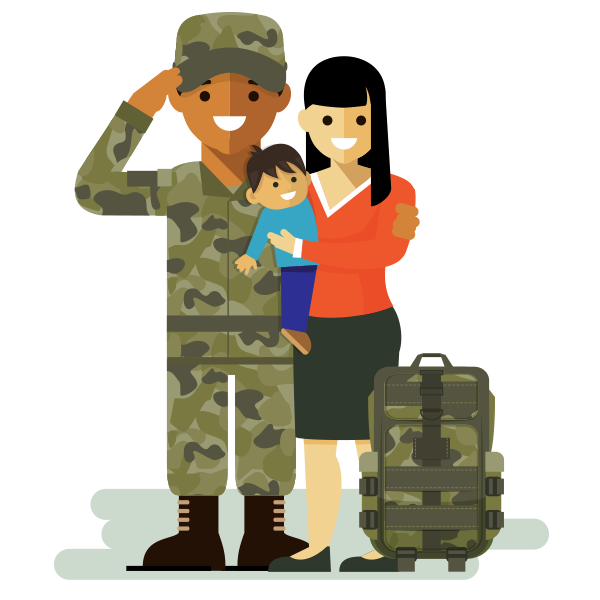Learn About Reentry and Retention Programs for Reservists
Learning Objectives
After completing this unit, you'll be able to:
- Plan ahead for military reservists’ absences.
- Create a reentry program for veterans and reservists.
- List ways to provide ongoing professional development for veterans.
Introduction
Did you know that U.S. service members are granted special rights under the law? The Uniformed Services Employment and Reemployment Rights Act (USERRA) protects job rights for veterans and military reservists. For example, it establishes 5 years as the length of time that an employee can be absent for military duty and retain reemployment rights.
The Family and Medical Leave Act (FMLA) provides certain employees with up to 12 weeks of unpaid, job-protected leave a year. The provisions of the FMLA for military families entitle employees to take leave for an exigency arising from the foreign deployment of the employee’s family member or to care for a service member with a serious injury or illness.
Plan Ahead for Reservists’ Absences
There are more than 800,000 military reservists in the United States. Typically they are required to report for duty at a nearby military base for one weekend each month and complete two weeks of field training exercises each year. This time commitment keeps them current on their military skills in the event they are required to mobilize in a time of need. Some reservists -- not all -- may be “mobilized” (which means called into active duty) for a longer period in times of conflict or disaster. A teammate’s temporary absence might sound challenging but doesn't have to be difficult to manage if you are prepared.

There’s great business value in employing a reservist despite mobilizations and deployments. For example:
- It is an investment in future leadership of the company.
- Temporary worker costs for filling these vacancies may be lower than rotating full-time hires.
Other important considerations when planning ahead to minimize the impact of reserve duty are:
- Do you want to engage temporary workers to fill the reservist’s role?
- Who on the team can step up to take on additional responsibilities for a while?
- What’s the impact on the reservist after being away for more than 2 weeks?
- What is the transition plan for handing over responsibilities before and after mobilization?
If you would like to learn more about the unique needs of Reservists, develop a relationship with the local chapter of the Employer Support of the Guard & Reserve (ESGR) organization.
Characteristics of Veteran-Friendly Reentry Programs
Military-friendly companies make it possible for military reservists and members of the national guard to serve when called into action. They plan ahead to cover responsibilities when these service members are mobilized. And they consider how to ease the return to work for these employees once the deployment is over.
Here are some important considerations for crafting a reentry and career continuation plan.
- Communicate a clear "return to work" schedule and expectations.
- Facilitate continued communication with the company's leave administrator (usually a company who manages leave plans on behalf of a company).
- Continue 401(k) benefits during paid leave.
Here are some other considerations that can ease return and increase retention for reservist employees.
- Temporary flexible work arrangements or a ramped schedule during the employee’s transition back to work
- Allowance for remote or part-time work if necessary to accommodate the employee's changing needs (for example, a relocation)
- Quota deferment for sales employees
- Continued use of company phones and IT equipment as normally provided by the company
Professional Development Opportunities for Veterans

Corporate career exploration helps veterans discover opportunities where they fit best at a company. Skill-development programs help them prepare for those roles. Finding that perfect fit can inspire veterans to stay at your company for the long haul. It also can help develop your company’s leadership pipeline for the future.
Let’s look at some examples of career-development programs for veterans.
Trailhead Military
Trailhead Military is the Salesforce job training and career accelerator program for military service members, veterans, and spouses. Through the online community and in-person classes, Trailhead Military connects members to free training and career opportunities at Salesforce and in the vast ecosystem of Salesforce customers and partners.
JP Morgan Chase
JPMorgan Chase offers veterans a range of tools and resources to support their acclimation and professional development, including two formal programs. Through a 12-week guided internship, veterans apply skills from their military background while learning about the company’s products, services, and businesses. The internship creates a pipeline of new candidates who can earn a permanent placement at the company. A 2-year rotational program focuses on training veterans for leadership and skill-specific career paths at the company.
The Benefits of Rotational Job Programs
Like anyone else making a dramatic career shift, veterans can find that their individual preferences change once they’ve settled into a new job. We all have an idea of what we prefer, but we likely don’t know enough to judge an industry or role until we get to work and start solving problems with our teammates. Rotational programs allow transitioning military veterans to rapidly adapt to changes in their preferences and make corrections to their career course. Ultimately, that can lead to higher job satisfaction and increased employee retention.
Let’s Sum It Up
Now that you have some strategies to successfully incorporate military veterans into your workplace, consider what resources you already have at your company: veterans on staff, allies, and maybe even an ERG focused on veterans.
The job doesn’t stop with building the environment. Look for opportunities to match veterans with mentors who can guide them through career-growth opportunities. And keep in mind the characteristics of military-friendly retention programs.
Resources